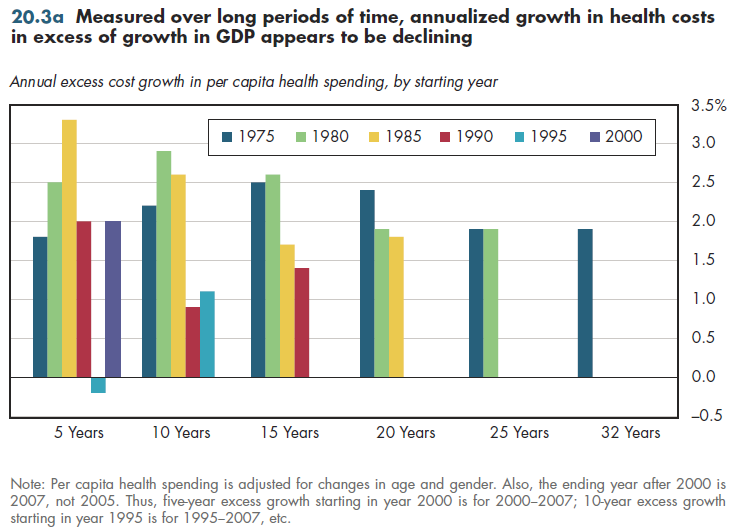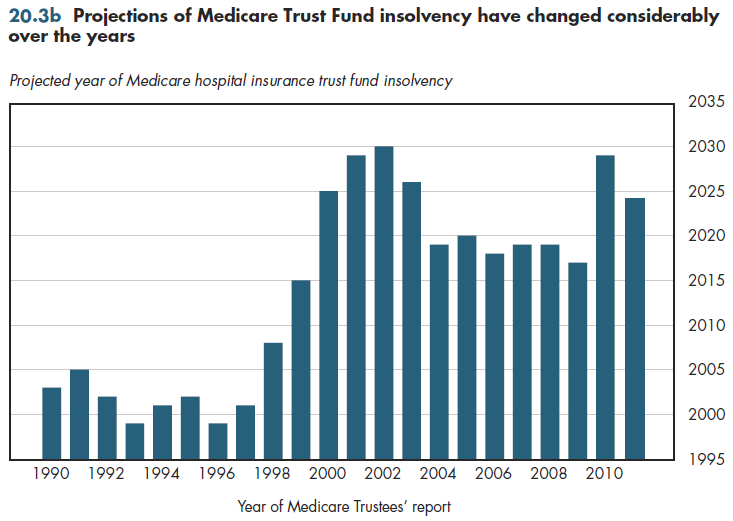Download PowerPoint versions of both figures.
Inside Collection (Book): American Health Economy Illustrated
20.3 How Much Faster per Capita Health Spending Has Increased Relative to GDP Growth
Summary: The excess cost ratio measures how much faster per capita health spending—adjusted for changes in age and gender—increased relative to growth in per capita GDP. Historical variations in the excess cost ratio make predicting future health spending difficult, especially over a long time.
"Excess cost growth" is the name for the residual just described. It is the difference between the U.S. per capita growth rate in age- and gender-adjusted health care costs minus the per capita growth in GDP (both rates are calculated from inflation-adjusted estimates of health spending and GDP). The level of excess cost growth has varied over time. Not surprisingly, this variation has been largest when short (five-year) time intervals are used (figure 20.3a). Over longer periods, there is less variation (but part of the reason is because the observed periods overlap).

Excess cost growth from 1940-1990 was 2.3 percent a year. The data from the longest periods illustrated in figure 20.3a (25 and 32 years) suggest that excess cost growth might have declined to less than 2 percent. However, certainty is impossible to achieve. During this period, many policy changes in Medicare (introduction of a prospective payment system for hospitals in 1983, establishment of the Medicare physician fee schedule in 1992, substantial Medicare cost-containment measures in 1997) might have had the effect of temporarily slowing growth in spending, thereby masking the underlying trend having to do with technology that might continue in the future.
Forecasts of the year in which the Medicare Trust Fund is exhausted have varied substantially over 20 years (figure 20.3b). This is not to suggest that government forecasters are incompetent. First, by their nature, official projections of Medicare spending by Medicare Trustees or of Medicare, Medicaid, and total health spending by the CBO reflect only current policy. Policy can and did change in response to these forecasts. Remember this when using hypothetical forecasts in the following pages to explore whether current trends in health spending are sustainable in the future. Uncertainty is an unavoidable feature of long-term forecasts.

Downloads
References
- Boards of Trustees, Federal Hospital Insurance and Federal Supplementary Medical Insurance Trust Funds, The. 2010 Annual Report. US Government Printing Office. August 5, 2010.
- Department of Health and Human Services. Centers for Medicare and Medicaid Services.
Collection Navigation
- « Previous module in collection 20.2 Technology Has Been a Key Driver of Health Spending Growth
- Collection home: American Health Economy Illustrated
- Next module in collection » 20.4 Projected Real GDP per Capita Will Decline within 30 Years Due to Growth in Health Spending
Content actions
Give feedback:
Download:
Add:
Reuse / Edit:
Twin Cities Campus:
- © 2012 Regents of the University of Minnesota. All rights reserved.
- The University of Minnesota is an equal opportunity educator and employer. Privacy
- Last modified on Sep 24, 2013 3:07 pm -0500









